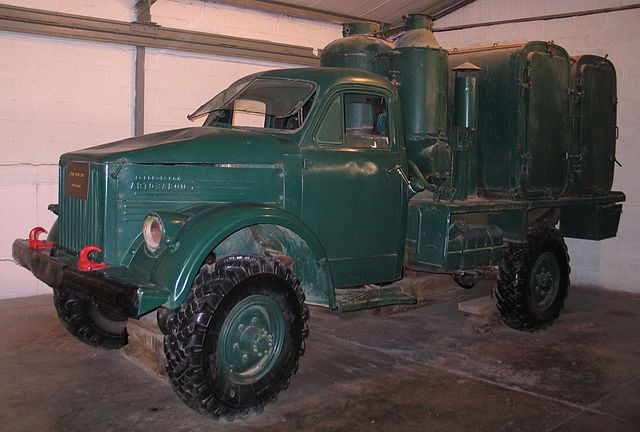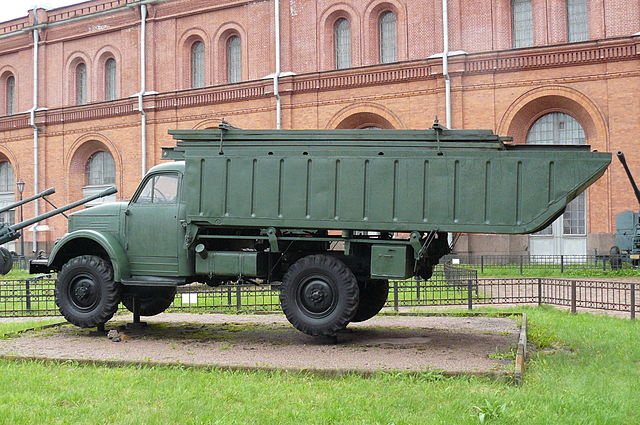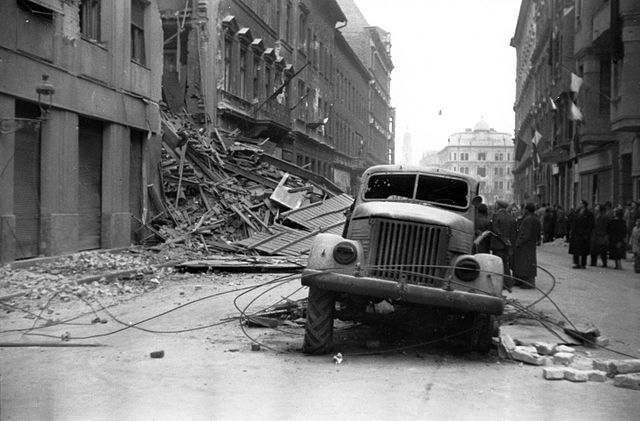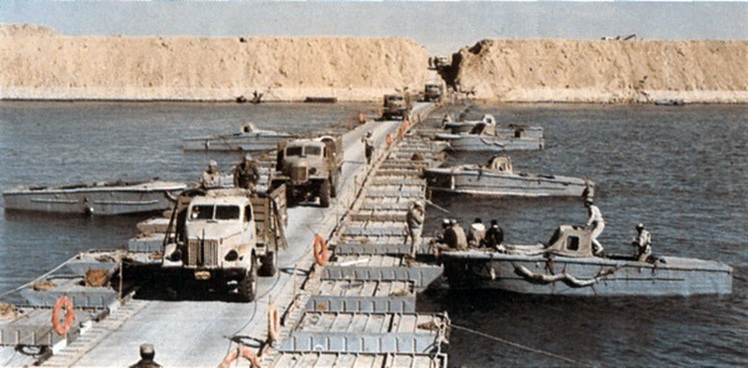GAZ 63
 Soviet Union
Soviet Union
Light 4x4 Truck (1948-68) - 474,464 built
The GAZ 63 was a 4x4 miitary variant of the GAZ-51 based on the WW2 lend-leased stuebaker truck. The GAZ-63 was produced until 1968 to c474,000 vehicles in USSR alone. It was declined inti 18 versions, exported and used by China (licence), Hungary, Poland (licence), Romania, Syria and Ukraine. Some are still in ciculation today.
About the GAZ-63
Development
Its start on the assembly line coincided with the beginning of the Cold War, which threatened to turn hot. And he finished his production journey exactly 20 years later - in the year when Soviet tanks entered Prague. But the world war, fortunately, did not break out either in these two decades or later. Probably, this is also why the GAZ-63 can be found “alive” even today...
It has never been a secret that all-wheel drive vehicles in the USSR were created primarily for the army. And at the end of the forties, when yesterday’s allies became potential adversaries, the country urgently needed new military vehicles, because the main fleet of all-wheel drive vehicles of the Soviet army during the Great Patriotic War were American models. However, our factories had the design groundwork. At Gorkovsky, in particular, an all-wheel drive truck was designed before the war.
In the second half of the thirties of the last century, the truck was created unified with the GAZ-11-51, which was supposed to replace the outdated GAZ-MM lorry in production. The model, like other new products from Soviet factories, was planned to be put on the assembly line in 1942. Based on the GAZ11-51, the all-wheel drive GAZ-63 and its version with a shortened wheelbase, the GAZ-62, were designed. The prototype appeared back in 1939–1940. Three-axle models with indexes 33 and 34 were also developed. The leading designer of the projects was the author of many models with all driving axes P.A. Grachev.
Work on the trucks that were to be put on the assembly line after the war continued as soon as the Germans were driven away from Moscow. When fine-tuning the GAZ63, Gorky engineers obviously truckefully studied the Lend-Lease Chevrolet G-7107. Such trucks, close to the 63rd in layout, were assembled at GAZ during the war. However, the American version had a lower load capacity and dual-slope wheels at the rear.
In 1943, a sample of the GAZ-63 appeared with a slightly modified American Studebaker cabin. By this time, P.I. became the leading designer of the 63rd. Muzyukin is, by the way, the chief designer of UAZ in the future. The final version of the GAZ-51 and GAZ-63 cabins was created not without the influence of the same Studebaker, but the Soviet cabin with rounded wings and large headlights built into them was noticeably more modern. Developments on the three-axle GAZ-33 were transferred to Moscow, where they were used to create the ZIS151. The Gorky residents simply did not have a powerful enough engine for such a truck.
Well, the GAZ-63, as usual, was shown in the Kremlin in 1945, among other trucks. True, production was slightly delayed. GAZ-51 entered production in 1946. Large-scale production of the all-wheel drive truck began on September 31, 1948. Soviet reference books indicated 1946 for a long time. But at this time we could only talk about the so-called zero series, the vehicles of which were subject to controlled operation. The designers received the 63rd Stalin Prize. By the way, in those years bonuses were given out to engineers, including automotive ones, quite often. And there was a reason...
Final Vehicle

GAZ-63 production
According to modern terminology, the GAZ-63 can even be considered a truckgo-passenger vehicle. In the body with high sides there were folding benches on the sides. You had to have the stamina of a soldier or feel the most urgent need to go somewhere in order to sit for a long time in the back of this rigid (with spring suspension) bouncy truck. But anything is better than crossing the abysses of the Soviet off-road on foot!
According to the passport, the load capacity of the GAZ63 on asphalt was 2000 kg, on the ground - 1500 kg. But who counted them, these kilograms, somewhere on a distant collective farm or a timber industry enterprise forgotten by the regional committee authorities? And the truck could also pull a trailer weighing up to 2000 kg - read: a light gun.
The truck's maneuverability was excellent! With all single wheels, it had almost identical front and rear tracks, plus ground clearance, depending on the tires, amounting to 270–280 mm, and approach and departure angles of 48° and 32°, respectively. In addition, there was a transfer case with a reduction gear (1.96). Since the gear ratio of the first stage of the gearbox was 6.40, you could even plow the all-wheel drive “lawn” if you wanted (of course, adding ballast to the body). There was also a version of the GAZ-63A - with a winch. In general, in the right hands, the 63rd could drive where it was sometimes strucky to go.
Just the engine thrust would be enough! The GAZ-63 had a GAZ-51 unit - a descendant of the pre-war GAZ-11, copied from the Dodge D5. By the way, this engine was produced until the end of the 80s! At 63 it developed only 70 hp. at 2800 rpm and 205 Nm at 1500–1700 rpm. The truck was only capable of a maximum speed of 65 km/h (children's speed in modern times). However, this indicator is, of course, not the main one for such a machine. Much more important for Soviet realities is that thanks to the additional (relative to the GAZ-51) gas tank, the A-66 gasoline supply (yes, there was one!) was 195 liters. The truck, consuming on average 25–29 liters per 100 km, could travel approximately 650 km without refueling.
But the driver also had to match the truck. There is very little space between the steering wheel and a simple sofa. Vacuum-driven windshield wipers worked slower the faster the truck was traveling. At first, the cabin did not even have a heater; it appeared only in 1952. It’s even somehow inconvenient to talk about the absence of power steering and brakes in relation to this soldier-like ascetic truck.
But the most important disease of a tall, narrow-gauge vehicle was poor stability. The tendency to rollover at high speeds can be forgiven - not its modes. But even off-road, especially on slopes, the driver had to be alert. However, that’s why he is a driver, and not just a user. From a person who was entrusted with such a serious truck (and who was also taught to patch the chamber, “shake up” the truckburetor, or even jam the piston), it is logical to expect skills in overcoming off-road conditions.
Of course, the plant knew about the lack of stability. Therefore, prototypes with a wider track and a different cabin were designed and built. But the modernized truck was not put into production. All efforts and resources were directed towards a fundamentally new model - GAZ-66. In the meantime, the 63rd gave birth to several, including very interesting, modifications.
Even during the war, P.A. Grachev designed a wheeled self-propelled gun, unified in chassis with the 63rd GAZ-68 (aka SU 63). But this model did not go into production either. In contrast, by the way, to the BTR-40 armored personnel truckrier, many of its components and assemblies were also common to those used on the GAZ-63.
And there were other, practically civilian, modifications: the GAZ-63P truck tractor, designed for a semi-trailer weighing up to 6000 kg, and its version 63D - with a power take-off for a dump semi-trailer. Both trucks had dual-slope rear wheels. Several versions of fire engines, tanks for transporting fuel, oil and milk, and ambulance vans were built on the GAZ-63 chassis. The Kurgan Bus Plant built a small number of KAVZ-663 - all-wheel drive buses on the GAZ-63 chassis, with a body similar to the Gorky GZA-651 and similar vehicles produced by many large and small factories in the USSR. Among the prototypes based on the GAZ-63 were versions with a soft roof for airborne troops, and a half-track prototype.
Until 1968, when the 63rd gave way to the 66th on the assembly line, 474,464 trucks were produced. For a long time they met on the roads, and sometimes on city streets. Of course, despite the strength and simplicity of the design, over the years there have been fewer and fewer tall trucks with “toothy” tires. But then, already in the 80s, 63 began to “float up” from army warehouses - well-groomed and in good condition. As a rule, it is these “demobilized” copies that belong today to fans of Soviet retro. The lower-valve “sixes” are not at all young, but are still ready to go where they cannot go without special training, the “lawns” are still purring in the same way - in a fighting manner. Almost like in the years of their youth, when the 63, together with the whole country, were preparing for a big war. Which, fortunately, never started.
Other tech specifics
The GAZ-63 had a frame structure, all-wheel drive with a switchable front axle (two driveshafts to the drive axles and an intermediate one between the gearbox and transfer case), short overhangs and single wheels with adjustable internal pressure.
Car tires measuring 280–457 mm made it possible to briefly reduce the pressure to 0.7 kg/cm2 when driving on virgin snow or wetlands. In this case, the vehicle speed should not exceed 10 km/h. The service life of the tires during such driving did not exceed 150 km (when operating with a normal pressure of 2.8 kg/cm2, the warranty mileage of the tires is 10 thousand km). The compressor, of course, was missing.
To inflate tires in the field, a device was used that was screwed into the engine instead of one of the spark plugs. The engine started and ran on five cylinders, the piston of one of the cylinders pumped air into the tires. You should not think that a gasoline-air mixture entered the tires. The inlet air valve of the device had significantly less resistance than the intake manifold and carburetor with an inertia-oil air cleaner.
Variants

GAZ-63 specialized NBC chemical cleansing vehicle

GAZ-63 pontoon truck

Tanker variant
The GAZ-63 was exported to socialist and, "developing countries". They were produced under Soviet license in North Korea and China. In the DPRK the truck was called “Sungri-61” (“victory”). In the People's Republic of China, 63 were made under the name “Yuejin NJ230”. They differed in many ways from the original. The North Korea variant for example had lights integrated into a more stremaling hood. The Initial Chinese version was simplified with straight angle cabin and mufflers.
Main variants
- GAZ-63A: Version with front-mounted winch.
- GAZ-63U/AU: Export versions
- GAZ-63D: Tractor-trailer, with dual rear wheels.
- GAZ-63E: Bus chassis (PAZ-659 and PAZ-663)
- GAZ-63EU: Modernized Export version of the 63E
- GAZ-63P: Tractor-trailer with dual rear wheels but no PTO as on GAZ-63D.
- GAZ-63PU: Export version of the latter
- GAZ-63Ye: Version with shielded electrical equipment.
- GAZ-63AYe: Same with front-mounted winch.
- GAZ-63YeU: Export version of GAZ-63Ye
Prototypes
- GAZ-63V: Prototype, modernized with larger wheels, lowered loading platform, parking brake, shielded electrical equipment, rear turn signals, coolant overheat warning indicator.
- GAZ-63AV: same but front-mounted winch, canvas topped cab, all metal body with stretcher mounts, canvas loading compartment cover, new instrument panel, unshielded electrical equipment.
- GAZ-66: Prototype improved GAZ-63 with BRDM-1 wxles and wheels, more modern cab designed by B.B. Lebedev (also for the GAZ-52).
- GAZ-66A: Prototype replacement with GAZ-52F elemants, but same loading platform, transfer case and winch. Axles from GAZ-63V, wheels from the BAV 485.
- GAZ-66P: Prototype tractor-trailer (based on AZ-66A).
Operators

Soviet GAZ-63 damaged after an explosion, Prague Spring 1968

Egyptian GAZ-63 across the Suez canal, 1973 offensive
- China
- Hungary
- Egypt (most probable)
- Poland
- Romania
- North Korea
- Syria
- Ukraine
- USSR
| Specs GAZ-63 |
| Dimensions LWH : | 5,525 x 2,200 x 2,245m - Wheelbase 3,300m |
| Total weight, curb/full: | 3,200/5,350 tons |
| Tires : | 9.75–18 (from the mid-1950s – 10.00–18) |
| Tracks : | 1588 front, 1600 rear |
| Ground clearance : | 27 cm (1 in) |
| Crew : | 2+8 |
| Propulsion: | 6 cyl. GAZ 3485 cm3 70hp/51.5 comp. ratio, 2800 rpm, Tq Nm 205 1500–1700rpm |
| Transmission: | Gearbox Mechanical 4-speed, transfer case 2-speed |
| Suspensions: | All-wheel drive type, leaf springs |
| Brakes: | Disc ft and rear, hydraulic |
| Speed : | 65 km/h (30 mph) |
| Range (road/off road) : | 500 Miles, consumpt. 1L/100 km at 40 km/h |
| Payload : | 2000 kgs (on ground – 1500) |
| Production | Circa 474,000 |
Sources
museum.gaz.ru/
51 on en.wikipedia.org
63 on ru.wikipedia.org
off-road-drive.ru
engine.aviaport.ru
www.gaz20.spb.ru
off-road-drive.ru
autoar.org
books.google.fr/
ru.wikipedia.org
enisovets.ru/gaz/gazpages/gaz51v
denisovets.ru/gaz/gazpages/gaz51u
zr.ru/
CC photos